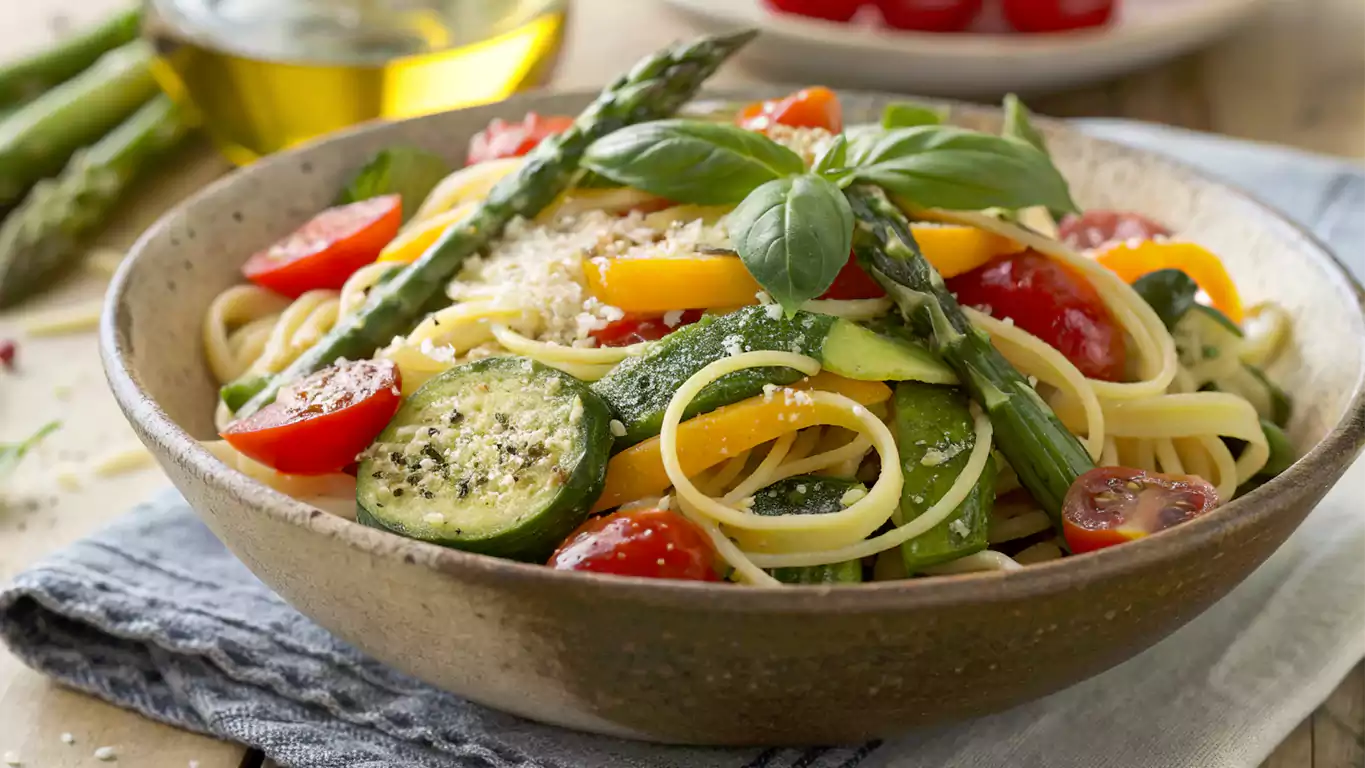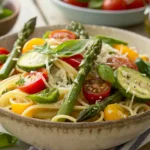There’s something truly magical about spring—everything feels fresh and full of life. The air is warmer, flowers are blooming, and the produce is vibrant and plentiful. One of the best ways to embrace the season is through cooking, and there’s no better dish to embody the spirit of spring than Spring Garden Pasta.
Picture yourself sitting down to a plate filled with colorful vegetables and a light, flavorful pasta that feels as refreshing as the season itself. It’s simple yet satisfying, healthy yet indulgent. Whether you’re in the mood for a quick weeknight meal, a light lunch, or something to impress guests at a dinner party, Spring Garden Pasta is your go-to dish.
In this guide, you’ll learn how to make the best Spring Garden Pasta, highlighting the natural flavors of seasonal vegetables like zucchini, asparagus, and cherry tomatoes. You’ll also discover how this recipe is fully customizable, allowing you to add protein, make it vegan, or switch up the veggies based on what’s available at your local market. Let’s get cooking!
What is Spring Garden Pasta?
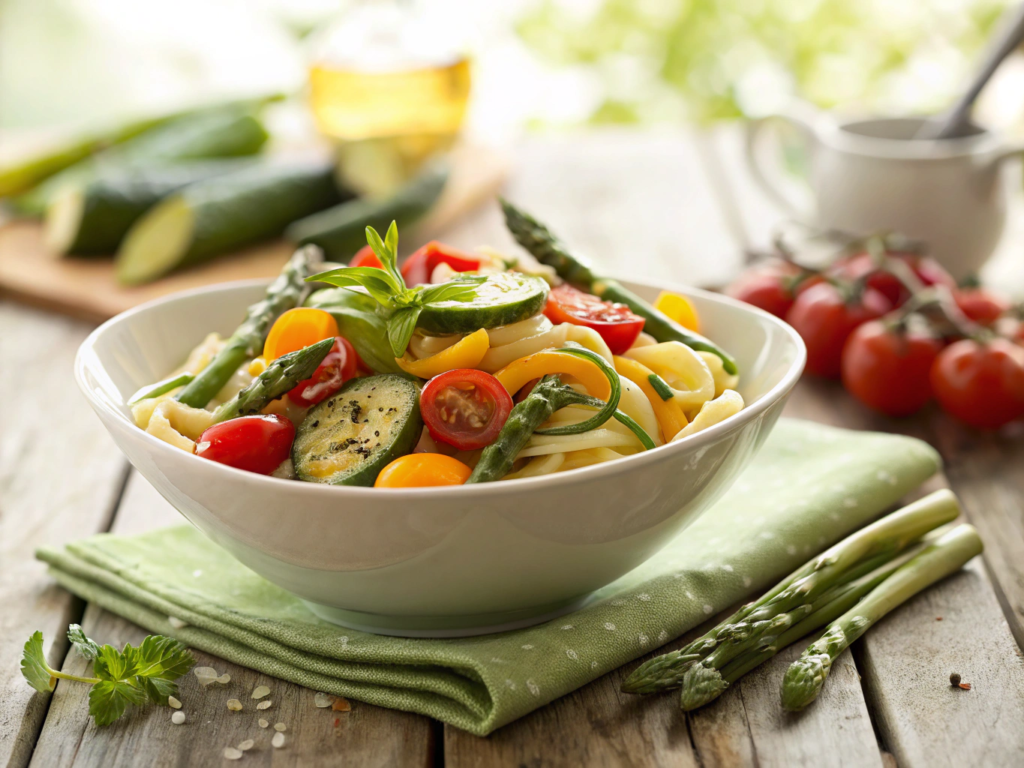
Spring Garden Pasta isn’t just another pasta dish—it’s a celebration of spring’s bounty. This dish highlights fresh, vibrant vegetables that are at their peak during the season, combined with light, wholesome pasta for a meal that’s both satisfying and nutritious.
The beauty of Spring Garden Pasta lies in its simplicity. Unlike traditional pasta dishes that are heavy on rich, creamy sauces, this recipe focuses on bringing out the natural flavors of seasonal produce. It’s a light yet filling dish, perfect for those who want to enjoy a flavorful meal without feeling weighed down.
The dish is highly customizable, allowing you to swap out vegetables, add protein, or even experiment with different pasta shapes. Whether you’re cooking for yourself, a loved one, or a crowd, Spring Garden Pasta is a versatile and crowd-pleasing meal that everyone will love.
Why You Will Love This Recipe
- Fast and Easy: You can have this dish ready in under 30 minutes, making it ideal for busy weeknights or quick weekend meals.
- Healthy & Nutritious: Packed with fresh vegetables, this dish is a great way to incorporate more nutrients into your diet.
- Make it your own: Experiment with different ingredients to suit your taste. Feel free to customize this dish by incorporating your preferred vegetables or proteins.
- Perfect for Any Occasion: Whether it’s a casual family dinner, a special date night, or a meal prep staple, Spring Garden Pasta is a hit for any event.
Ingredients for the Perfect Spring Garden Pasta
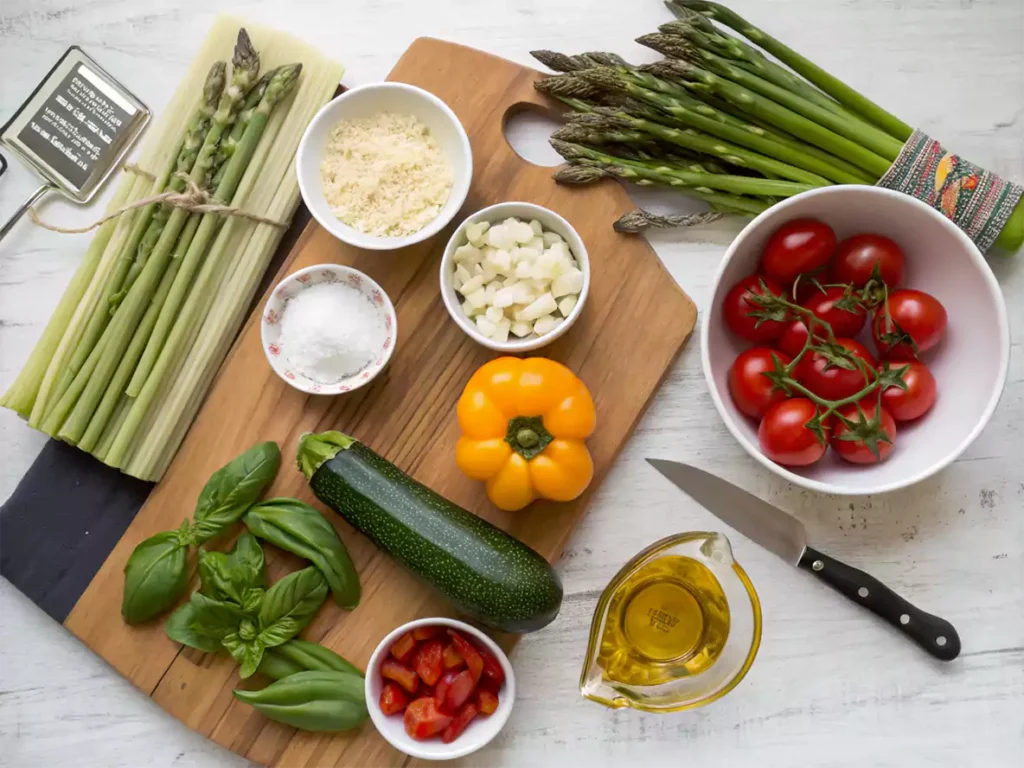
The key to a delicious Spring Garden Pasta lies in the quality of your ingredients. For this recipe, you’ll want to focus on seasonal vegetables and fresh, wholesome ingredients that allow the flavors to shine. Here’s what you’ll need:
Main Ingredients
| Ingredient | Quantity | Notes |
|---|---|---|
| Pasta (whole wheat, gluten-free, or regular) | 12 oz | Choose your favorite type, such as penne or spaghetti |
| Olive oil | 2 tbsp | Extra virgin for best flavor |
| Garlic (minced) | 3 cloves | Enhances taste and aroma |
| Cherry tomatoes | 1 cup | Adds a touch of natural sweetness |
| Zucchini (sliced) | 1 medium | Adds texture and freshness |
| Asparagus (chopped) | 1 cup | Perfect for spring, tender yet flavorful |
| Bell peppers (sliced) | ½ cup | Adds color and crunch |
| Fresh basil | ¼ cup | Essential for fragrance and taste |
| Parmesan cheese (or nutritional yeast for vegan) | ¼ cup | Optional but recommended for added flavor |
| Lemon zest | 1 tsp | Adds brightness and zest |
| Salt & Pepper | To taste | Enhances the natural flavors |
These ingredients combine to create a beautiful, balanced dish that’s light but full of flavor. The zucchini, bell peppers, and asparagus are the stars of the show, providing both texture and vibrant color. The cherry tomatoes add a sweet burst, and the basil gives the dish an aromatic finish.
Step-by-Step Instructions: How to Make Spring Garden Pasta
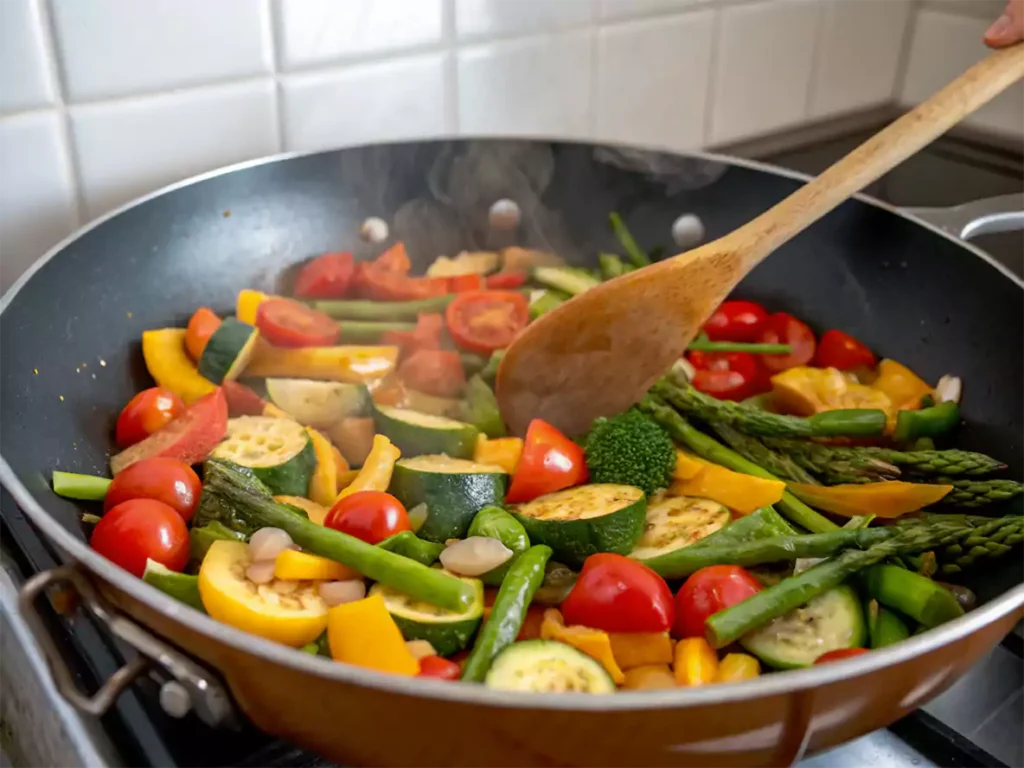
Follow these easy steps to create the best Spring Garden Pasta:
🔪 Step 1: Prepare the Vegetables
Before you start cooking, wash and chop your vegetables. This is an important step to ensure that everything cooks evenly. Here’s a pro tip: slice your vegetables uniformly so they cook at the same rate. For example, slice the zucchini into rounds or half-moons, chop the asparagus into bite-sized pieces, and halve the cherry tomatoes. This will make the dish look more appealing and ensure the flavors meld together perfectly.
🍳 Step 2: Cook the Pasta
Heat a big pot of water with salt until it comes to a boil. Salted water helps the pasta cook evenly and enhances the flavor. Once the water is boiling, add your pasta and cook according to the package directions, making sure it’s al dente (firm to the bite). Once the pasta is done, drain it and set it aside, reserving ½ cup of pasta water to use later in the recipe.
🔥 Step 3: Sauté the Vegetables
Warm the olive oil in a spacious pan over medium heat. Sauté the garlic for about 30 seconds, or until it becomes fragrant. Then, add the asparagus, zucchini, and bell peppers. Cook for about 5 minutes, stirring occasionally, until the vegetables are slightly tender but still vibrant. Next, toss in the cherry tomatoes and cook for another 2 minutes, just until they soften and release their juices.
🍋 Step 4: Combine and Serve
Now it’s time to bring everything together! Add the cooked pasta into the pan with the sautéed vegetables. Pour in the reserved pasta water to help create a light sauce that coats the pasta. Toss everything together to combine. Stir in the lemon zest and fresh basil. For extra flavor, sprinkle some Parmesan cheese (or nutritional yeast for a vegan version) over the top. Season with salt and pepper to taste. Serve immediately and enjoy this refreshing, flavorful meal!
Variations & Customizations
One of the best things about Spring Garden Pasta is its flexibility. Here are some ways to make the dish your own:
Protein Add-Ons
If you’d like to add protein to the dish, here are a few great options:
- Grilled chicken: Add lean protein for a hearty dish.
- Shrimp: Perfect for a seafood twist.
- Tofu: A great option for a vegan or vegetarian version.
Extra Flavor Enhancements
Want to elevate the flavor profile? Here are some ideas:
- Mushrooms: Add sliced mushrooms for an earthy, umami flavor.
- Pesto: Swap the lemon zest for a pesto sauce for a herbaceous finish.
- Red pepper flakes: Add a pinch of red pepper flakes for a slight kick of heat.
Serving Suggestions & Pairings
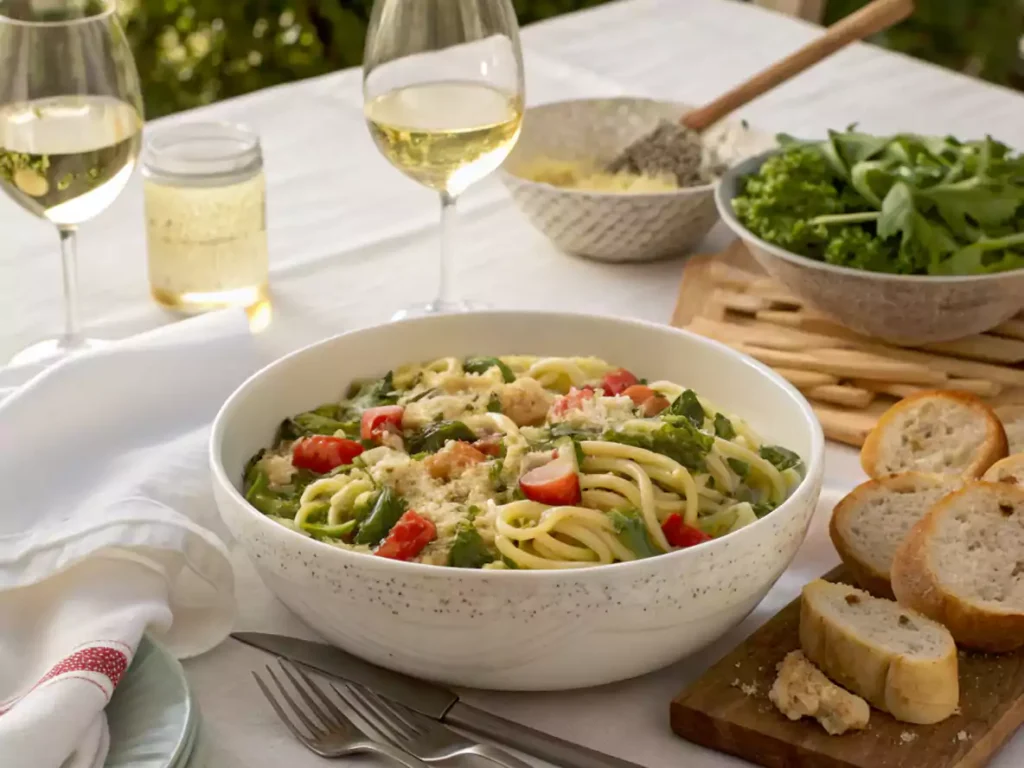
Side Dishes
For a complete meal, pair Spring Garden Pasta with these sides:
- Garlic bread: Warm, buttery bread is always a hit.
- Fresh salad: A crisp salad with a light vinaigrette complements the freshness of the pasta.
- Roasted vegetables: If you have leftover veggies, roast them in the oven for a deeper flavor.
Wine Pairing
A glass of crisp Sauvignon Blanc or light Pinot Grigio pairs perfectly with the fresh flavors of this dish. These wines balance the acidity of the tomatoes and complement the herbs.
FAQs About Spring Garden Pasta
What’s the best pasta for Spring Garden Pasta?
Any type works, but for a healthier option, whole wheat or gluten-free pasta are excellent choices. They add extra fiber and nutrients while still maintaining a delicious flavor.
Can I make Spring Garden Pasta ahead of time?
Yes! This dish can be stored in an airtight container in the refrigerator for up to 3 days. It makes for a great meal prep option or leftovers for lunch the next day.
How can I make this dish vegan?
To make Spring Garden Pasta vegan, simply skip the cheese or use nutritional yeast instead of Parmesan. The rest of the ingredients are naturally plant-based!
Can I add a creamy sauce to Spring Garden Pasta?
Absolutely! For a creamier twist, you can try adding a light lemon butter sauce or make a cashew-based cream for a dairy-free version. This will add a rich, indulgent texture to the dish.
Conclusion:
Now that you know how to make the best Spring Garden Pasta, it’s time to bring this delicious, vibrant dish to your table. Whether you’re making it for a quick weeknight dinner or a special gathering, Spring Garden Pasta is guaranteed to impress. It’s easy to make, customizable to your tastes, and packed with fresh, healthy ingredients that make you feel good about what you’re eating.
Try out this Spring Garden Pasta and let your creativity shine! We’d love to see your sweet creations. Tag us on Instagram at @SweetEatsRecipes and use the hashtag #SpringGardenPasta to get featured.
Spring Garden Pasta
Equipment
- Large pot
- Large pan
- Colander
- Knife and Cutting Board
- Tongs or spoon for stirring
- Grater (optional, for cheese or zesting lemon)
Ingredients
- 12 oz Pasta (whole wheat, gluten-free, or regular)
- 2 tbsp Olive oil
- 3 cloves Garlic (minced)
- 1 medium Zucchini (sliced)
- 1 cup Asparagus (chopped)
- ½ cup Bell peppers (sliced)
- ¼ cup Fresh basil
- ¼ cup Parmesan cheese
- 1 tsp Lemon zest
- To taste Salt & pepper
Instructions
- Prepare the Vegetables: Wash and chop all vegetables. Slice zucchini, chop asparagus, and halve cherry tomatoes. This helps in even cooking and creates an attractive dish.
- Cook the Pasta: Bring a large pot of salted water to a boil. Add the pasta and cook according to the package instructions (about 8-10 minutes for al dente). Reserve ½ cup of pasta water before draining.
- Sauté the Vegetables: In a large pan, heat olive oil over medium heat. Add minced garlic and sauté for about 30 seconds until fragrant. Add asparagus, zucchini, and bell peppers, cooking for 5 minutes. Toss in cherry tomatoes and cook for an additional 2 minutes.
- Combine and Serve: Add the drained pasta to the vegetables in the pan. Pour in reserved pasta water to help create a light sauce. Stir in lemon zest and fresh basil. Optionally, sprinkle with Parmesan cheese. Season with salt and pepper to taste. Serve immediately and enjoy.
Notes
- Customization Tips: Feel free to add proteins like grilled chicken, shrimp, or tofu to make this dish heartier.
- Vegan Option: Skip the Parmesan and use nutritional yeast for a vegan-friendly alternative.
- Storage: Leftovers can be stored in an airtight container in the fridge for up to 3 days. It makes great meal prep for lunches.

